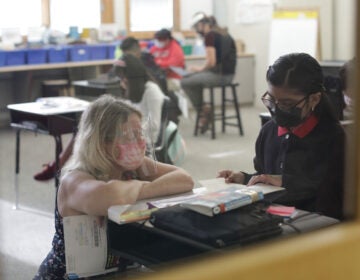State lays out plans for school construction projects, but no funding
Schools Development Authority lists projects to address overcrowding, building age in 18 districts

Groundbreaking for SDA construction project. (SDA)
This article originally appeared on NJ Spotlight.
–
In court over the state’s stalled school construction program, the Murphy administration has quietly moved ahead in at least identifying the next priority projects, two dozen of them in 18 districts.
The Schools Development Authority (SDA) in late January approved its latest strategic plan, listing 24 projects facing the most-dire needs due to overcrowding and building age.
There is no money in place to pay for them, the subject of a lawsuit filed in November as part of the landmark Abbott v. Burke school equity litigation. Representing schoolchildren in 31 low-income, urban districts, advocates have contended the state has failed to live up to its commitment under Abbott rules to provide adequate school facilities.
But the Murphy administration in its first response brief filed this week said the strategic plan meets at least one of the demands in the complaint, and it’s next up to the Legislature to provide the necessary funding.
“While the State recognizes that additional funding will be needed for the projects identified in the new Statewide Strategic Plan, it has alerted the Legislature to that need and, with that new Statewide Strategic Plan now in place, the State is positioned to move forward,” reads the brief filed by Deputy Attorney General Donna Arons.
David Sciarra, executive director of the Education Law Center (ELC), which is leading the litigation, said in an interview this week that it looks like the administration has deferred to the Legislature, but it hardly addresses the issue.
Deadline for state funding
Sciarra said he has asked the court to set a deadline of June 30 for the state to commit the funding, surely to be in the billions of dollars.
“Looks like the Murphy administration is just throwing this back to the Legislature,” he said this week.
Nonetheless, one of the demands in the ELC complaint was that the state set forth the next projects to be addressed, and the strategic plan does just that. The plan outlines deep needs to alleviate overcrowding and building age in many of the districts, and pulls from more than 300 projects that have been identified by local districts.
“This Statewide Strategic Plan provides the sequencing of SDA activities that will address the significant overcrowding and aging infrastructure needs that exist in many SDA districts and identifies a first tranche of projects toward addressing those needs,” said SDA spokeswoman Edythe Maier in an email yesterday.
The projects identified by the SDA are the following:
- Garfield: two new schools, preschool-grade 5
- Paterson: high school addition/renovation
- Bridgeton: addition/renovation for preschool, grades 6-8 and grades 9-12
- Passaic City: new high school
- Pleasantville: new elementary school
- Perth Amboy: new preschool
- Jersey City: new preschool
- West New York: new school, preschool-grade 8
- Camden: two new schools, preschool-grade 8
- Newark: two replacement schools, preschool-grade 8
- Salem City: one replacement school, preschool-grade 8
The following are identified as locations where overcrowding needs to be addressed, but the specific projects and locations have yet to be finalized:
- Elizabeth: preschool-grade 12
- New Brunswick: preschool-grade 8
- City of Orange: preschool, grades 6-8
- Union City: preschool-grade 8
- Plainfield: preschool-grade 5
- East Orange: preschool
- Trenton: preschool-grade 5
WHYY is your source for fact-based, in-depth journalism and information. As a nonprofit organization, we rely on financial support from readers like you. Please give today.




